1997 PONTIAC GRAND AM climate control
[x] Cancel search: climate controlPage 88 of 371
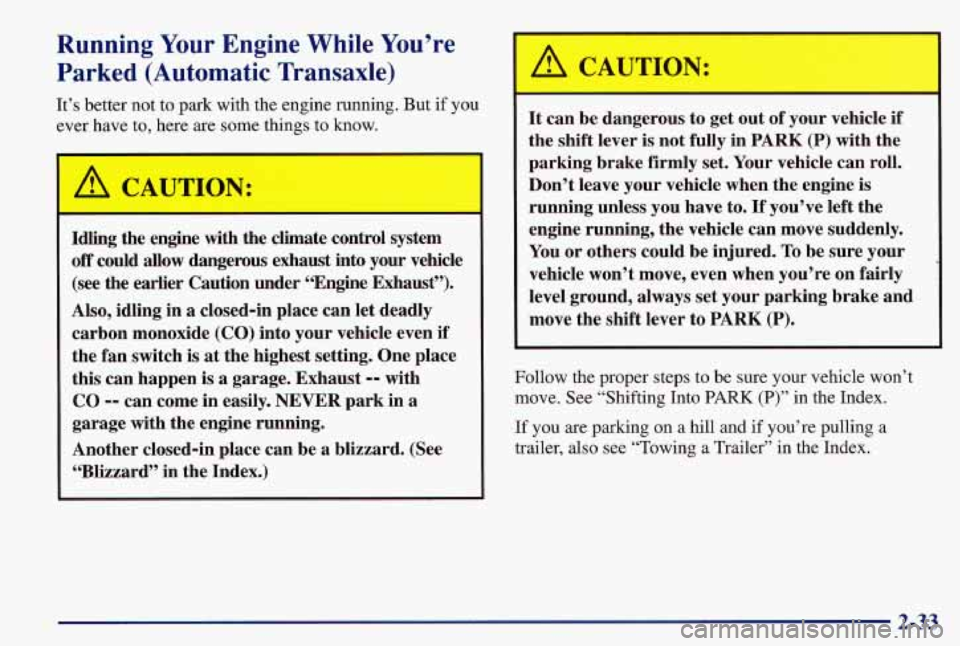
Running Your Engine While You’re
Parked (Automatic Transaxle)
It’s better not to park with the engine running. But if you
:ver have to, here are some things
to know.
h
A CAUTION:
Idling the engine with the climate control system
off could allow dangerous exhaust into your vehicle
(see the earlier Caution under “Engine Exhaust”),
Also, idling in a closed-in place can let deadly
carbon monoxide (CO) into your vehicle even if
the fan switch is at the highest setting. One place
this can happen is
a garage. Exhaust -- with
CO
-- can come in easily. NEVER park in a
garage
with the engine running.
Another closed-in place can be a blizzard, (See
“Blizzard” in the Index.)
I
A CAUTION:
It can be dangerous to get out of your vehicle if
the shift lever is not fully in PARK (P) with the
parking brake firmly set. Your vehicle can roll.
Don’t leave your vehicle when the engine is
running unless you have to.
If you’ve left the
engine running, the vehicle can move suddenly.
You or others could be injured. To be sure your
vehicle won’t move, even when you’re on fairly
level ground, always set your parking brake and
move the shift lever to PARK (P).
Follow the proper steps to be sure your vehicle won’t
move. See “Shifting Into
PARK (P)” in the Index.
If you are parking on a hill and if you’re pulling a
trailer, also see “Towing a Trailer” in the Index.
2-33
Page 110 of 371

Your instrument panel is designed to let you know at a glance how your vehicle is running. You’ll know how fast
you’re going, how much fuel you’re using, and many other things you’ll need to drive safely and economically.
The main components
of your instrument panel are:
A. Fuse Panel
B. Vent
C. Turn SignalMultifunction Lever
D. Supplemental Restraint System (SRS)
E. Hazard Warning Flashers Switch
E Instrument Cluster
G. Windshield WipersNasher Stalk
H. Audio System
I. Side Window Defogger Vent
J. Glove Box
K. Climate Control System L. Gear Shift Lever
M. Cupholder/Ashtray
(If Equipped)
N. Enhanced Traction System (ETS) Switch
0. Accessory Power Outleaighter (If Equipped)
(If Equipped)
P. Ignition Switch
Q. Tilt Steering Wheel Lever (If Equipped)
R. Fog Lamp Switch
S. Instrument Panel Intensity Controlhterior
Lamps Switch
T. Hood Release Handle
2-55
Page 126 of 371
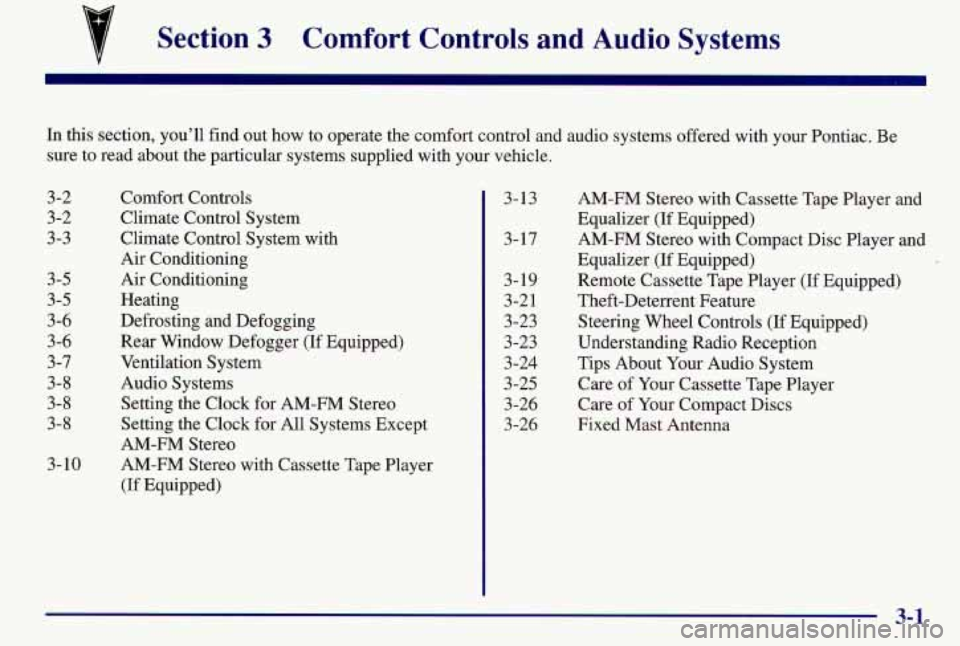
Section 3 Comfort Controls and Audio Systems
In this section, you’ll find out how to operate the comfort control and audio systems offered with your Pontiac. Be
sure to read about the particular systems supplied with your vehicle.
3-2
3-2
3-3 3-5
3-5
3-6 3-6
3-7
3-8 3-8
3-8
3-10 Comfort Controls
Climate Control System
Climate Control System with
Air
Conditioning
Air Conditioning
Heating
Defrosting and Defogging
Rear Window Defogger (If Equipped)
Ventilation System
Audio Systems
Setting the Clock for AM-FM Stereo
Setting the Clock for All Systems Except
AM-FM Stereo
AM-FM Stereo with Cassette Tape Player
(If Equipped) 3-13
3-17
3-19
3-2
1
3-23
3-23
3-24
3
-25
3-26
3-26 AM-FM
Stereo with Cassette Tape Player and
Equalizer
(If Equipped)
AM-FM Stereo with Compact Disc Player and
Equalizer (If Equipped)
Remote Cassette Tape Player
(If Equipped)
Theft-Deterrent Feature
Steering Wheel Controls (If Equipped)
Understanding Radio Reception
Tips About Your Audio System
Care of Your Cassette Tape Player
Care of Your Compact Discs
Fixed Mast Antenna
3-1
Page 127 of 371
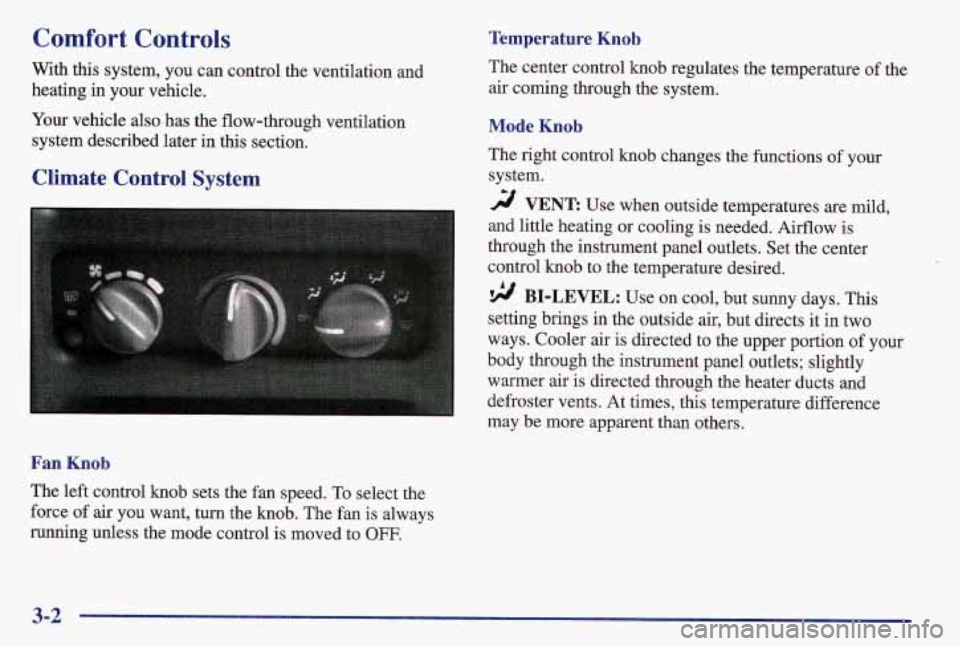
Comfort Controls
With this system, you can control the ventilation and
heating
in your vehicle.
Your vehicle also has the flow-through ventilation
system described later in this section.
Climate Control System
Fan Knob
The left control knob sets the fan speed. To select the
force of air you want, turn the knob. The fan is always
running unless the mode control is moved to
OFF.
Temperature Knob
The center control knob regulates the temperature of the
air coming through the system.
Mode Knob
The right control knob changes the functions of your
system.
2 VENT Use when outside temperatures are mild,
and little heating or cooling is needed. Airflow is
through the instrument panel outlets. Set the center
control knob to the temperature desired.
9 BI-LEVEL: Use on cool, but sunny days. This
setting brings in the outside air, but directs
it in two
ways. Cooler air
is directed to the upper portion of your
body through the instrument panel outlets; slightly
warmer air is directed through the heater ducts and
defroster vents. At times, this temperature difference
may be more apparent than others.
3-2
Page 128 of 371
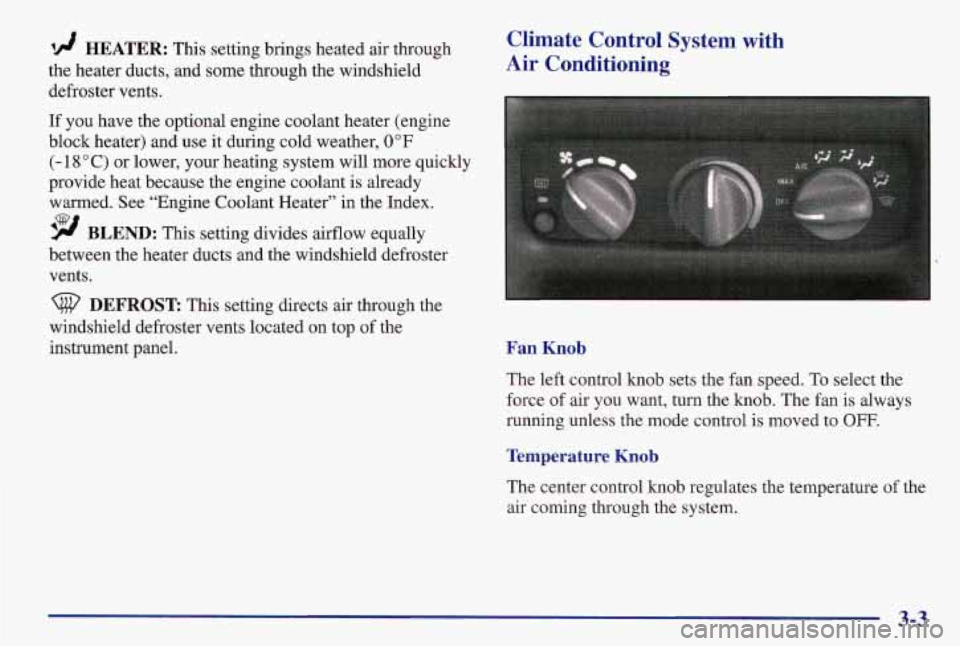
d HEATER: This setting brings heated air through
the heater ducts, and
some through the windshield
defroster vents.
If you have the optional engine coolant heater (engine
block heater) and use it during cold weather,
0°F
(- 18°C) or lower, your heating system will more quickly
provide heat because the engine coolant is already
warmed. See “Engine Coolant Heater” in the Index.
9 BLEND: This setting divides airflow equally
between the heater ducts and the windshield defroster
vents.
DEFROST This setting directs air through the
windshield defroster vents located on top
of the
instrument panel.
Climate Control System with
Air Conditioning
Fan Knob
The left control knob sets the fan speed. To select the
force of air
you want, turn the knob. The fan is always
running unless the mode control is moved
to OFF.
Temperature Knob
The center control knob regulates the temperature of the
air coming through the system.
3-3
Page 273 of 371
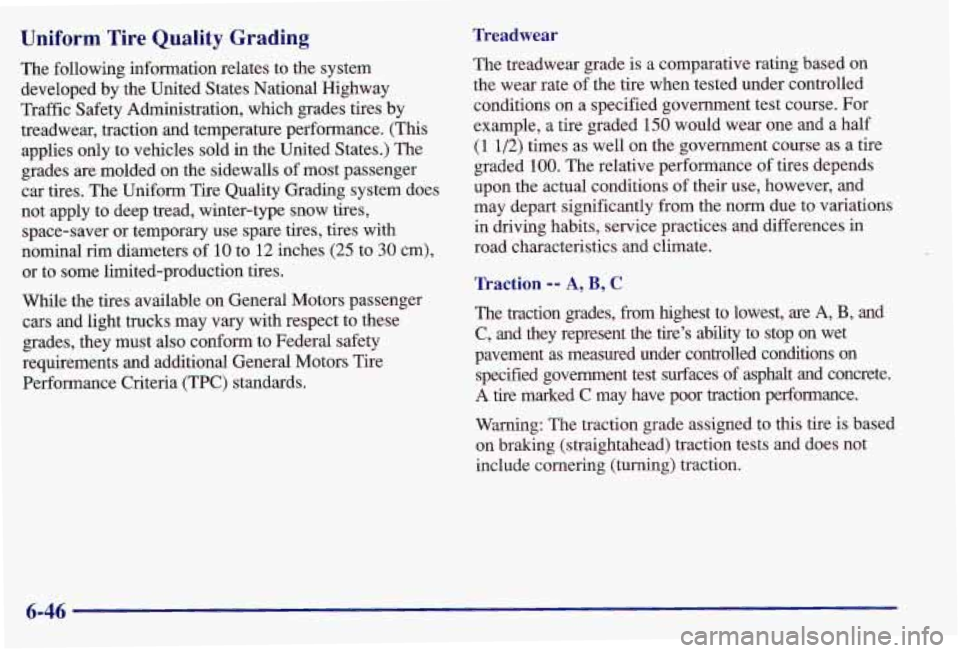
Uniform Tire Quality Grading
The following information relates to the system
developed by the United States National Highway
Traffic Safety Administration, which grades tires by
treadwear, traction and temperature performance. (This
applies only to vehicles sold in the United States.) The
grades are molded on the sidewalls of most passenger
car tires. The Uniform Tire Quality Grading system does
not apply to deep tread, winter-type snow tires,
space-saver or temporary use spare tires, tires with
nominal rim diameters of
10 to 12 inches (25 to 30 cm),
or to some limited-production tires.
While the tires available on General Motors passenger cars and light trucks may vary with respect to these
grades, they must also conform to Federal safety
requirements and additional General Motors Tire
Performance Criteria (TPC) standards.
Treadwear
The treadwear grade is a comparative rating based on
the wear rate of the tire when tested under controlled
conditions on a specified government test course. For
example,
a tire graded 150 would wear one and a half
(1 1/2) times as well on the government course as a tire
graded
100. The relative performance of tires depends
upon the actual conditions of their use, however, and
may depart significantly from the norm due to variations
in driving habits, service practices and differences in
road characteristics and climate.
Traction -- A, B, C
The traction grades, from highest to lowest, are A, B, and
C, and they represent the tire’s ability to stop on wet
pavement as measured under controlled conditions on specified government test surfaces of asphalt and concrete.
A tire marked C may have poor traction performance.
Warning: The traction grade assigned to this tire is based
on braking (straightahead) traction tests and does not
include cornering (turning) traction.
6-46
Page 361 of 371
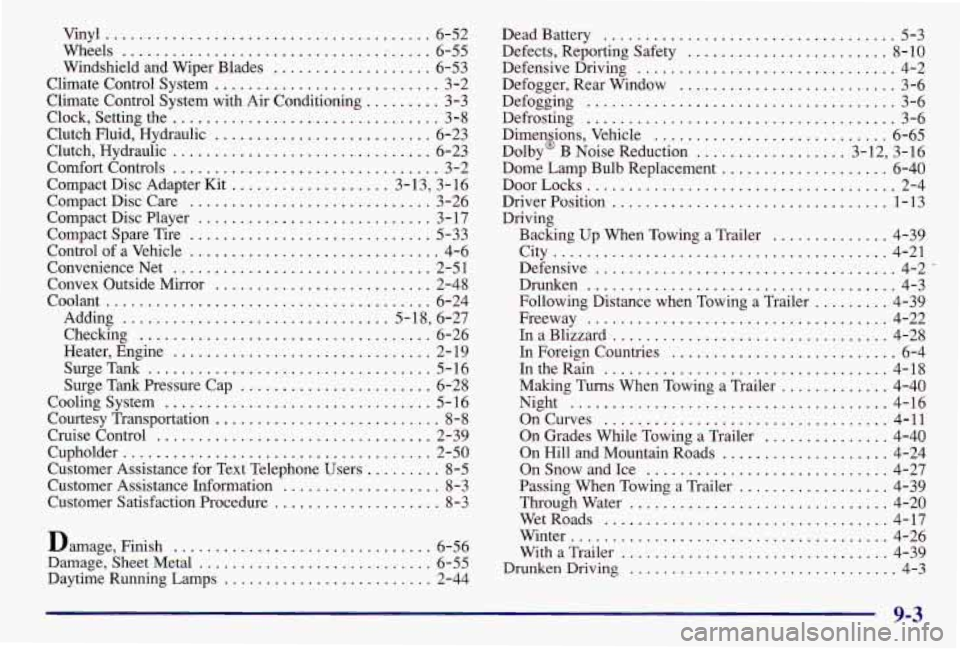
Vinyl ....................................... 6-52
Wheels
...................................... 6-55
Windshield and Wiper Blades
................... 6-53
Climate Control System
........................... 3-2
Clock, Setting the
................................ 3-8
Clutch Fluid, Hydraulic
.......................... 6-23
Clutch, Hydraulic
............................... 6-23
Comfort Controls
................................ 3-2
Compact Disc Adapter Kit
................... 3-13, 3-16
Compact Disc Care
............................. 3-26
Compact Disc Player
............................ 3 - 17
Compact Spare Tire
............................. 5-33
Control of a Vehicle
.............................. 4-6
Convenience Net
............................... 2-5 1
Convex Outside Mirror .......................... 2-48
Coolant
....................................... 6-24
Adding
................................ 5-18, 6-27
Checking
................................... 6-26
SurgeTank
.................................. 5-16
Climate Control System
with Air Conditioning
......... 3-3
Heater, Engine
........... ............... 2-19
Surge Tank Pressure Cap
....................... 6-28
Cooling System
................................ 5-16
Courtesy Transportation ........................... 8-8
Cruise Control
................................. 2-39
Cupholder
..................................... 2- 50
Customer Assistance for Text Telephone Users
......... 8-5
Customer Assistance Information
................... 8-3
Customer Satisfaction Procedure
.................... 8-3
Damage, Finish
............................... 6-56
Damage, Sheet Metal
............................ 6-55
Daytime Running Lamps
......................... 2-44 Dead Battery
................................... 5-3
Defects. Reporting Safety
........................ 8-10
Defensive Driving ............................... 4-2
Defogger. Rear Window
.......................... 3-6
Defrosting
..................................... 3-6
Dimensions. Vehicle
............................ 6-65
Dolby@ B Noise Reduction
.................. 3- 12. 3- 16
Dome Lamp Bulb Replacement
.................... 6-40
DoorLocks
..................................... 2-4
Driver Position
................................. 1-13
Driving Backing Up When Towing
a Trailer .............. 4-39
City
........................................ 4-21
Defogging ..................................... 3-6
Defensive
.................................... 4-2 .
Drunken ..................................... 4-3
Following Distance when Towing a Trailer
......... 4-39
Freeway
.................................... 4-22
InaBlizzard
................................. 4-28
In Foreign Countries
............... ........ 6-4
IntheRain
.................................. 4-18
Making Turns When Towing a Trailer
............. 4-40
Night
...................................... 4-16
OnCurves
.................................. 4-11
On Grades While Towing a Trailer ............... 4-40
On Hill and Mountain Roads
.................... 4-24
On Snow and Ice
............................. 4-27
Passing When Towing a Trailer
.................. 4-39
Throughwater
............................... 4-20
WetRoads
.................................. 4-17
Winter
...................................... 4-26
With a Trailer
................................ 4-39
Drunken Driving
............................ 4-3
9-3